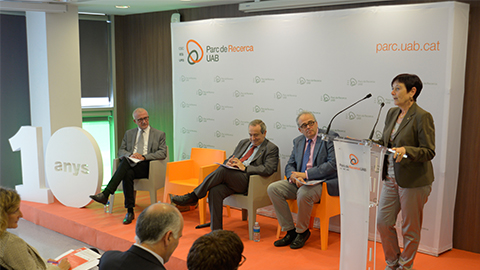PRUAB celebrates 10 years and looks to find new models of knowledge transfer

24/05/2017
The event brought together researchers, entrepreneurs, heads of departments and research institutes located on the campus of the Universitat Autònoma de Barcelona, as well as representatives of regional institutions and affiliated businesses.
The ceremony began with speeches by the highest representatives of the three founding institutions: Margarita Arboix, President of the Board and Rector of the UAB; Emilio Lora-Tamayo, President of the CSIC; and Josep Maria Monfort, Director General of IRTA. All three highlighted the tasks carried out by the UAB Research Park during these ten years to strengthen the relations between research and the business world. They also acknowledged the work done by those who created the park and continue to work there.
"In this decade we have created a true innovative and entrepreneurial ecosystem. Now the challenge lies in increasing the social and economic impact of the knowledge transfer activities conducted on campus", Rector Margarita Arboix stated. "There is a need to find new ways of tackling scientific and technological challenges and collaborating with researchers and businesses to give society answers to significant issues such as ageing, poverty or the environment", she indicated.
CSIC President Emilio Lora-Tamayo described PRUAB as a "first-order strategy" needed to face the changes produced by the generation of knowledge. "In a process of political and social transformation happening globally, with an increasingly competitive scientific model, there is a need to find strategies and alliances, establish synergies and use all available resources to conduct international projects”, he emphasised, while also praising the fact that CSIC, UAB and IRTA worked hand-in-hand to be "more present in this new world".
IRTA Director General Josep Maria Monfort recalled the people who made it possible to create the research park, stating that time had demonstrated that it was "a successful idea" and convinced of the promising future lying ahead.
The event also included a round table on the future of science parks and their role in the economy of knowledge, which was moderated by Javier Lafuente, PRUAB's Director and UAB's Vice-Rector for Innovation and Strategic Projects. The round table included Josep Miquel Piqué, President of IASP; Mariona Sanz, Director of the Business Innovation Department at ACCIÓ; Neus Sabaté, founder of Fuelium, and Pere Vallès, Director of Scytl.
Launching Innovative Businesses
As an instrument put to use in the transference of knowledge and technologies from the academic and research world to the professional sector, PRUAB has contributed to launching numerous entrepreneurial projects born from the research activities conducted on the UAB campus. Since its creation in 2007, the research park has given support to over 300 entrepreneurial projects and has helped launch 92 companies, with a success rate of more than 80%. These firms have created 850 new workplaces, 25% of which correspond to highly qualified profiles, and with an annual invoice of 50 million Euros.
Only in 2016 six new firms were created, among which are Bioeclosion, launched by researchers from the UAB Department of Chemistry and the UAB Institute of Biotechnology and Biomedicine with the aim of commercialising a biosensor capable of detecting gluten sensitivity in minutes with a drop of blood, and FutureSiSens, created by researchers from the UAB and the Institute of Microelectronics of Barcelona (IMB CNM - CSIC) which launched a thermoelectric sensor with silicon-based nanotechnology, with a self-sufficient energy supply and capable of detecting respiratory problems such as sleep apnoea or pneumonias.
Among the longest existing businesses of the UAB Research Park is the successful case of Scytl, specialised in the development of cutting-edge technology in electronic voting, currently operating in 47 countries and which this year closed an investment cycle of 12M Euros in addition to the 94M Euros it has earned since 2014. And Oxolutia, founded in 2010 by the Institute of Materials Science of Barcelona (ICMAB – CSIC), offers the market processes and materials developed in the field of applied superconductivity based on a nanotechnological approach.
Over 120 Collaborative Research Projects
One of the objectives of the UAB Research Park is to detect technological and social needs of the region's network of businesses and offer solutions through joint projects conducted with researchers from different disciplines. Thanks to the activities of the research park, over 120 R&D&i projects have been created involving researchers and businesses, with a total value of more than 6 million Euros.
A recently successful case of collaborative research is a project developed by the park with the Dormity.com company to create a personalised mattress recommendation system. For two years, researchers from the University Physiotherapy Research Service (EU Gimbernat), the Computer Vision Centre and the Centre of Prototypes and Hardware-Software Solutions of the UAB worked together with the company to develop this system and currently Dormity.com has installed it into ten of its stores.
Welcoming the R&D of Large Companies
The headquarters of the UAB Research Park is the Eureka Building, where during these past ten years 48 companies have had their home, including university spin-offs, S&M sized research-based companies and consolidated companies looking to boost their technological innovations in collaboration with the university's research centres and institutes. The Eureka building is home to the Advanced Technologies R&D&i laboratory of the multinational company Henkel, Lucta's Ingredients and Technology Innovation Unit, Zetes' Software R&D&i Department and the Oudernet olfactometry laboratory.
More information:
Photos of the event